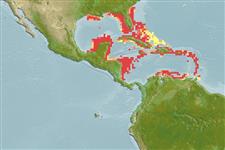Environment: milieu / climate zone / depth range / distribution range
Écologie
marin; profondeur 0 - 50 m (Ref. 189). Tropical; 32°N - 10°N, 94°W - 60°W (Ref. 189)
Western Central Atlantic: Beaufort, North Carolina south to Florida (USA); Antilles from Cuba to St. Lucia, also Trinidad, but not recorded at Blanquilla and Los Roques off Venezuela; also occurs off Panama.
Taille / Poids / Âge
Maturity: Lm ? range ? - ? cm
Max length : 11.0 cm TL mâle / non sexé; (Ref. 5217); common length : 9.0 cm TL mâle / non sexé; (Ref. 5217)
Épines dorsales (Total): 0; Rayons mous dorsaux (Total): 15-16; Épines anales 0; Rayons mous anaux: 10 - 18. Body slightly compressed; snout moderate, about 3/4 eye diameter; maxilla short with bluntly rounded tip, failing to reach pre-operculum by 1/2 pupil diameter; pseudobranch short, about 3/4 eye diameter; panamensis-type gill cover canals. Anal fin origin slightly behind base of last dorsal fin ray. A bright silver stripe along flank, about 3/4 or almost equal to eye, dark bordered above (Ref. 189). Body pale, few melanophores above, row of anal melanophores along anal-fin base. Eye orangish above, top of head with green and gold reflections (Ref. 7251).
Occurs in coastal waters, apparently not entering brackish water. Rare in Florida shore seine collections, but 'in great numbers under a night light', perhaps because it may stay some distance from the shore in daytime.
Life cycle and mating behavior
Maturité | Reproduction | Frai | Œufs | Fécondité | Larves
Spawn in school (Ref. 205).
Whitehead, P.J.P., G.J. Nelson and T. Wongratana, 1988. FAO Species Catalogue. Vol. 7. Clupeoid fishes of the world (Suborder Clupeoidei). An annotated and illustrated catalogue of the herrings, sardines, pilchards, sprats, shads, anchovies and wolf-herrings. FAO Fish. Synop. 125(7/2):305-579. Rome: FAO. (Ref. 189)
Statut dans la liste rouge de l'IUCN (Ref. 130435)
Menace pour l'homme
Harmless
Utilisations par l'homme
Pêcheries: pêcheries vivrières; appât: usually
Plus d'informations
RéférencesAquacultureProfil d'aquacultureSouchesGénétiqueElectrophoresesHéritabilitéPathologiesTraitementNutrientsMass conversion
CollaborateursImagesStamps, Coins Misc.SonsCiguateraVitesseType de nageSurface branchialeOtolithesCerveauxVision
Outils
Articles particuliers
Télécharger en XML
Sources Internet
Estimates based on models
Preferred temperature (Ref.
123201): 23.4 - 28, mean 26.4 °C (based on 226 cells).
Phylogenetic diversity index (Ref.
82804): PD
50 = 0.5000 [Uniqueness, from 0.5 = low to 2.0 = high].
Bayesian length-weight: a=0.00537 (0.00253 - 0.01141), b=3.13 (2.96 - 3.30), in cm total length, based on LWR estimates for this (Sub)family-body shape (Ref.
93245).
Niveau trophique (Ref.
69278): 3.2 ±0.4 se; based on size and trophs of closest relatives
Résilience (Ref.
120179): Haut, temps minimum de doublement de population inférieur à 15 mois (Preliminary K or Fecundity.).
Fishing Vulnerability (Ref.
59153): Low vulnerability (10 of 100).
